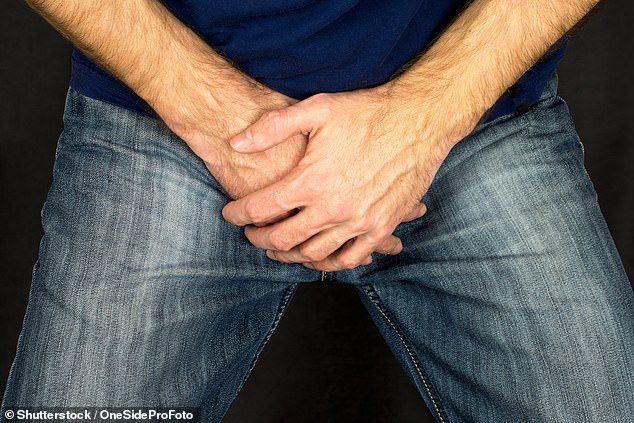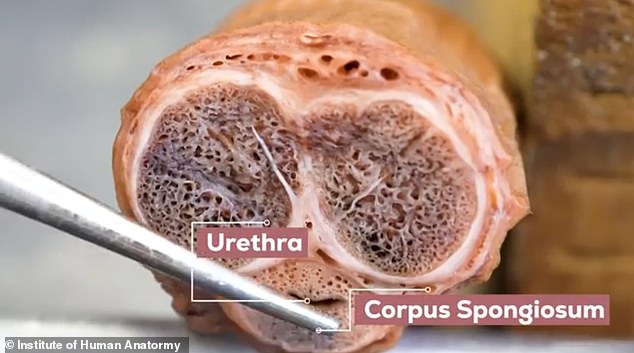It is a painful fate that affects around 150 men in England each year, according to official figures.
Penile fractures, or “broken penis,” are a painful injury that typically occurs as a result of vigorous sexual activity gone wrong.
Now, a new viral video, using a donated cadaver penis, shows exactly how the eye-watering injury occurs and how the boneless organ can actually “fracture.”
Released by the Human Anatomy Institute, an American cadaver laboratory, the video features the institute’s Jonathan Bennion discussing the parts of the male anatomy that actually get broken during a penile fracture.
He said: ‘Contrary to one of the slang terms used for an erect penis, there are no bones in the penis and therefore a penile fracture is not like a typical bone fracture.’
Now, a new viral video, using a donated cadaver penis, shows exactly how the eye-watering injury occurs and how the boneless organ can actually “fracture.”
Instead, he explained that what’s actually torn is a piece of internal connective tissue called the tunica albuginea, which is made mostly of collagen, that surrounds and supports the parts of the penis that fill with blood during an erection.
When a penile fracture occurs, it is the tunica albuginea that is torn, and such an injury is often accompanied by a distinctive popping, snapping, or clicking sound as it gives way.
As for what activities cause such a breakup, that can vary, Mr. Bennion explains.
One of the most common is what he calls an “aiming problem” during vigorous sexual activity.
“You missed the target and hit an immovable object, or in other words, another part of the body that was not intended to receive the penis,” he said.
‘This usually occurs during intense sexual activity because there has to be a certain level of force and/or speed to damage the penis.’
This most commonly occurs as a result of the penis snapping under the weight of a partner’s body or a strong, misdirected thrust that hits a hard part of the body.
Penile fractures could also occur if, for whatever reason, a man with an erection was playing a contact sport such as rugby, or if he received a physical blow to his erect penis during a fight or accident.
Mr Bennion said another potential cause was men trying to physically bend their penis to stop an erection, perhaps out of embarrassment or for cultural or religious reasons.
Signs of a penile fracture, aside from the aforementioned popping or cracking sound, include, unsurprisingly, a lot of pain and sudden loss of erection.

Official NHS data shows 164 penile fracture repairs were carried out in England in 2022-23, the latest data available
Mr Bennion adds that bruising, swelling and an “abnormal curvature of the penis” usually follow.
Although the circumstances of a penile fracture can be embarrassing, men should not delay seeking immediate medical help.
Mr Bennion explains that failure to seek urgent help increases the risk of complications such as erectile dysfunction, abnormal penis shape (medically called Peyronie’s disease) and pain during erections.
Surgery is usually required to repair penile fractures. The surgeon sews the tunica albuginea back together and repairs any other tissue, such as the urethra, the tube through which urine passes.
The general advice to avoid penile fractures in the first place is to make sure that any sexual intercourse you have is not of the type that will increase the chances of this happening.
Bennion says this includes being cautious with vigorous movements and “unusual or acrobatic positions” and stopping if things feel physically uncomfortable or painful.
For men looking to stop erections, Mr. Bennion recommends that instead of physically bending the penis, they do some exercise such as jumping jacks to redirect blood to other areas of the body.
Official NHS data shows 164 penile fracture repairs were carried out in England between 2022-23, the latest data available.
This represents an increase of 40 percent compared to a decade ago, when only 119 such operations were carried out.
The average age of a patient undergoing penile fracture repair was 44 years old according to the latest round of NHS data, with the youngest being under 15 and the oldest over 75.
A 2015 scientific study found that cowgirl, doggy style, and missionary positions were the most likely to cause penile fracture.

